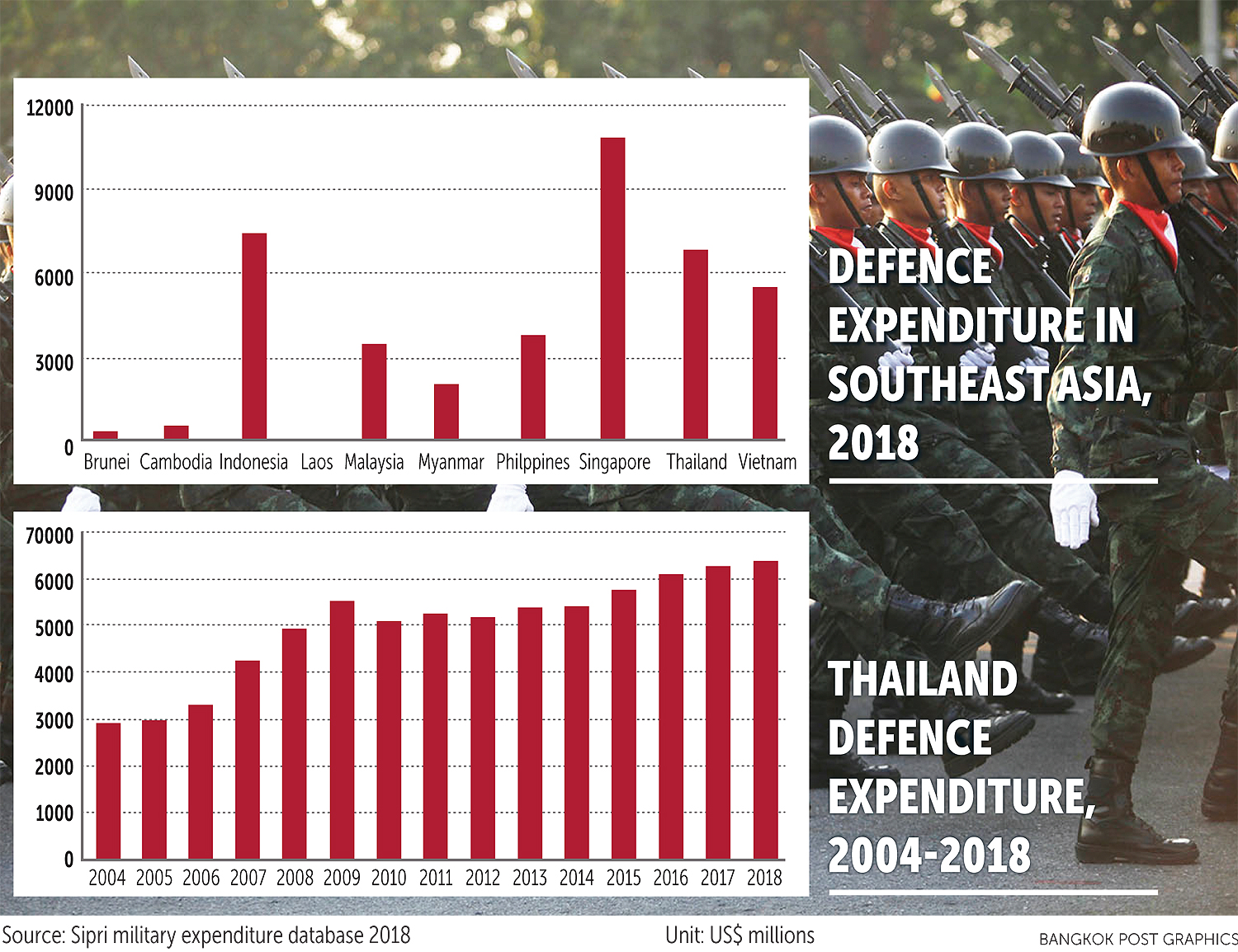
It goes without saying but, coups d'état are good for a military's bottom line. According to data recently published by the Stockholm International Peace Research Institute (Sipri), the Thai military has benefited handsomely from its repeated interventions in Thai politics.
Thailand had the third largest military budget in Southeast Asia in 2018 at US$6.8 billion (about 210 billion baht), accounting for 17% of total Asean defence spending.
Defence expenditures in Southeast Asia in 2018 totalled $40.8 billion, a 1.9% increase from 2017.
In Thai baht, the military's budget has increased 139% since their 2006 coup, though just 92.4% in constant US dollars. The budget has increased by over $1 billion since the 2014 coup.
In the past five years alone, the Royal Thai Armed Forces' budget increased 18.6% and 17.6% in baht and dollar terms, respectively.
As a percentage of GDP, Thai defence spending is quite modest at 1.3%. While it peaked in 2009 at 1.8%, since the 2006 coup, defence spending as a percentage of GDP has average 1.5%, below the Asean average of 1.9%. As a percentage of GDP, defence spending in Southeast Asia ranges from 0.7% in Indonesia to 3.1% in Singapore.
Thai defence expenditure as a percentage of government spending in 2018 was only 6.3%, below the Asean average 8.6%. Though it climbed to 8% in 2008 and 2009, following the coup, that proved to be unsustainable and since then it has been below 7% of government spending.
On a per-capita basis, Thailand's defence spending is the fourth highest in Asean at $99 which is still below the $150 Asean average that excludes Singapore. In the past decade, average Asean per capita defence spending has risen from $302 to $341. But if one excludes Singapore, it has been absolutely flat, rising from $150 in 2009, to $212 in 2014, before falling back to $149 in 2018.
In 2018, the Thai military began a 10-year modernisation programme. The military is asking for a $7 billion budget in 2019, with an extra $3 billion for other security-related issues. While the generals often hint of foreign threats, it's hard to see any serious causes for concern.

Thai defence spending really fails to take into account that of Thailand's four neighbours -- defence spending in two of them have fallen sharply, while it is a small fraction of Thai defence spending in the other two.
In 2018, Cambodia's official defence budget was only $543 million, the second lowest in the region (Laos is probably lower, but there is no data). Cambodia only represents 1% of Asean defence spending, though it has seen massive Chinese military assistance programmes.
Over the last five years, Malaysia's defence budget has contracted by 22%, from $4.1 to $3.2 billion, while Myanmar's has shrunk by 4.1%, using constant 2017 US dollars. Thailand's budget, in that same period grew by 17.5%.
Due to the $4.5 billion debt that the Pakitan Harapan government inherited from the government of Najib Razak from its huge 1MDB fraud case, Malaysian defence spending will continue to fall as the government predicts large deficits for the next few years. Government officials expect the 2019 budget to decline by 10%, to $3.3 billion. In the past decade, Malaysian defence spending as a percentage of GDP has been cut in half from 2 to 1%.
Myanmar's official defence budget in current dollars was $2.03 billion in 2018; a mere 5% of Asean's total; an 8.6% fall from 2017. In constant 2017 dollars the budget fell 4.1% between 2017 and 2018. Looking at the five-year trend, Myanmar saw a sharp increase in its military budget between 2014 and 2016. Since then it seems to have levelled off. Military spending as a percentage of GDP in Myanmar has always been among the highest in Southeast Asia. In 2015, it was 4.1%. In 2018, it fell to 2.9%, the first time it has ever been below 3%, but it remains well above the Asean average of 1.9%.
As a percentage of government spending, too, Myanmar is the second highest in Asean (15.2%), just below Singapore (17.1%). Local reporting suggests that the budget was only 14%. On a per-capita basis, however, Myanmar's defence spending of $37.7 puts it among the lowest in the region. While defence spending in Myanmar is likely to increase again, the country is beset with major insurgencies in Kachin and Rakhine states, as well as a number of smaller ones. The Tatmadaw requested a significant increase in its budget for 2019.
While Thailand has imported a few weapon systems from the United States, including 37 M1126 Stryker armoured personnel carriers and helicopters to keep the alliance on life-support, Thailand is often chasing Veblen goods, expensive platforms that they cannot afford to operate or do not need, such as a $411-million submarine deal with China (though scaled back from the original intended purchase of three).
While the military machinated its continued hold on politics following the March 2019 elections, the fragile coalition government has a host of pressing economic challenges that may curb some of the military spending. Nonetheless, the military-drafted constitution makes the military's budget and personnel decisions outside the purview of civilian leaders. If one is looking for the unexplained wealth of the more than 1,000 Thai generals, this is a good place to start.
The Thai military continues to be deeply involved in business ventures throughout the country. And more importantly, in certain regions such as the insurgency-plagued Deep South, the military controls civilian budgets for development projects.
But despite the surge in defence spending, the Royal Thai Army remains so obsessed with elite political machinations that their military readiness is far below what we should see. It's time to get the military back to barracks.
Zachary Abuza, PhD, is a professor at the National War College in Washington DC.
